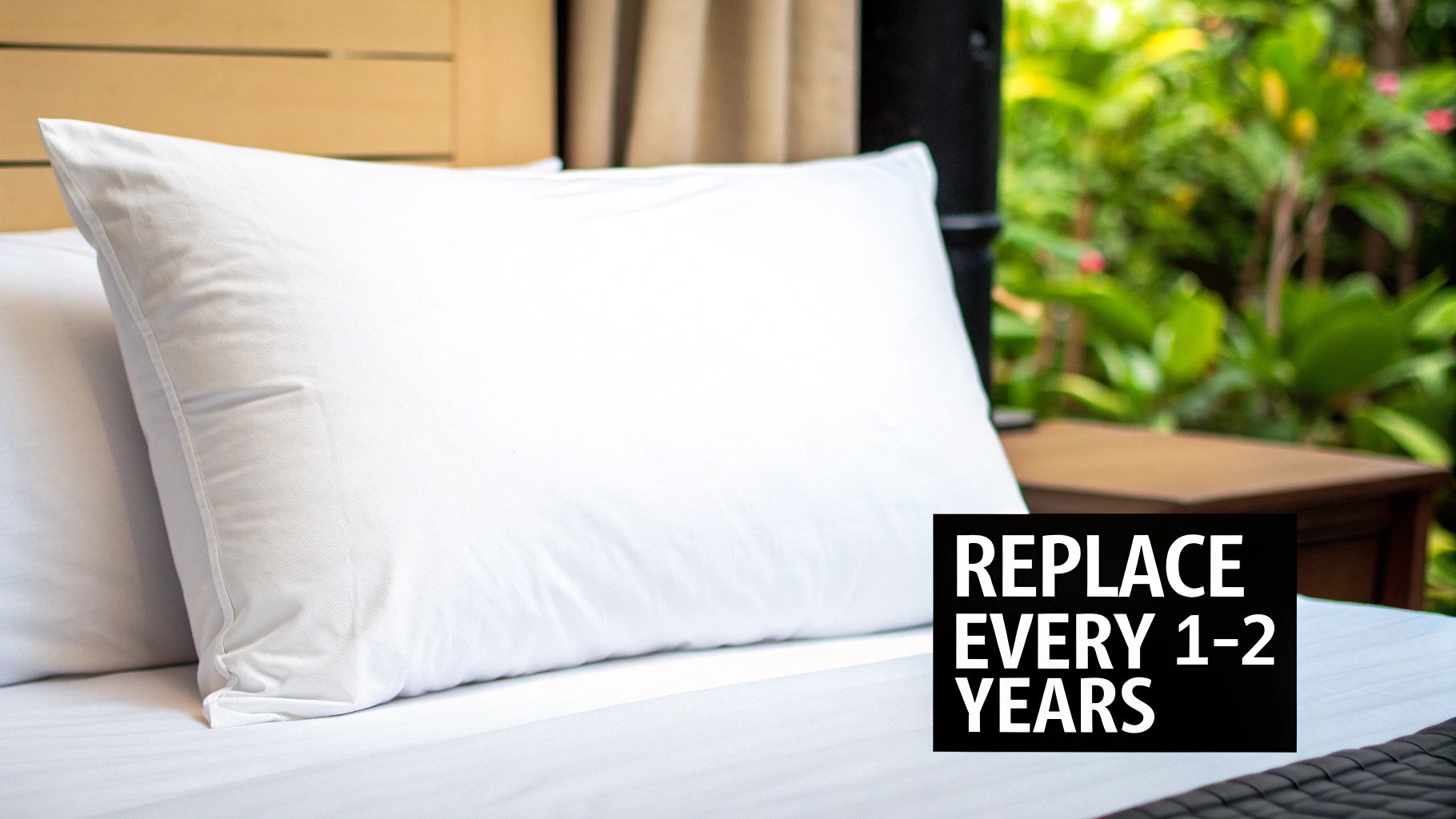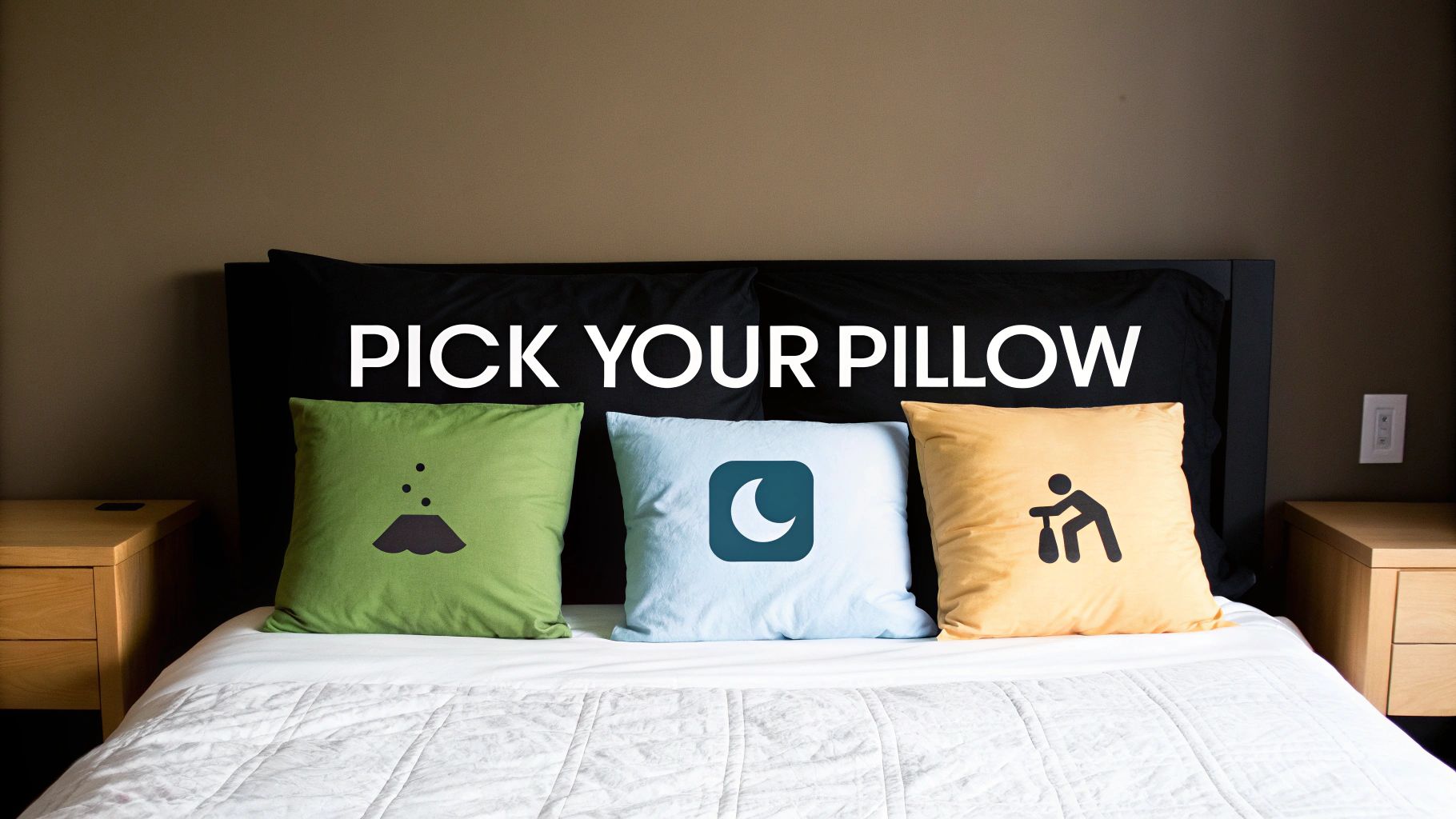Is your pillow secretly sabotaging your sleep? It’s a question worth asking, because the answer to how often should you replace your pillows is more frequently than most people think. The expert consensus is every one to two years. This isn't just about the joy of a fresh, fluffy pillow; it's a critical part of sleep hygiene that directly impacts your health and keeps your head and neck properly supported all night long. Think of it this way: you wouldn't run a marathon in worn-out shoes, so why would you spend a third of your life on a worn-out pillow?
Why Your Pillow Has an Expiry Date

It’s helpful to view your pillow as essential sleep equipment. Just like any high-use item, it degrades over time. Night after night, your pillow absorbs a cocktail of sweat, body oils, and dead skin cells. This creates a welcoming environment for dust mites and allergens which, according to research from the University of Manchester, can make up a significant portion of an old pillow's weight. This build-up can trigger allergies, disrupt your breathing, and ruin your sleep quality.
Here in Australia, sleep specialists at Bedshed support this one-to-two-year replacement cycle. Over time, the accumulated moisture can even encourage mould and bacteria to grow deep inside the filling—something you definitely don't want near your face.
More Than Just Hygiene
Beyond the invisible world living inside it, your pillow’s physical structure also breaks down. The filling gets compressed and flattened from nightly pressure, losing its loft and ability to support your head and neck correctly.
When a pillow stops doing its job, you’ll start to feel the consequences. This gradual loss of support can lead to:
- Poor spinal alignment, a common cause of neck pain, stiffness, and morning headaches.
- A serious drop in comfort, causing you to toss and turn trying to find a comfortable position.
- Broken, poor-quality sleep that leaves you feeling drained and unfocused the next day.
Your pillow is the foundation of a good night's sleep. Its condition directly impacts your physical health. Using a worn-out pillow is like driving on a flat tyre—sooner or later, it's going to ruin the whole ride.
Of course, a great pillow is only one part of the equation. Just as it needs a regular refresh, so does your mattress. Knowing how long mattresses should last is key to building a sleep environment that’s healthy from the ground up.
The Telltale Signs Your Pillow Is Past Its Prime
Forgetting when you bought your pillow is an easy mistake, but it's one that can seriously impact your sleep. While knowing how often should you replace your pillows provides a timeline, learning to spot the physical signs of wear and tear is the real secret to knowing when its time is up.
The classic fold test is one of the quickest checks. Simply fold your pillow in half, squeeze the air out, and hold it for 30 seconds. A healthy pillow will spring back to its original shape as soon as you let go. If it stays folded or unfurls slowly, its internal structure has broken down. It’s no longer giving you the support you need.
Look and Feel for Clues
Your senses are often the best judge. A pillow that’s past its use-by date will look and feel completely different, even if the change has been gradual.
Keep an eye out for these dead giveaways:
- Noticeable Lumps: If the filling feels clumpy and uneven, the materials inside have degraded and can no longer provide consistent support.
- Permanent Stains: We all sweat, but yellowish stains that won't wash out are a sign of a deep build-up of body oils and grime.
- It’s Gone Flat: Does your pillow look more like a pancake than a cushion? A pillow that has lost its loft can't give your head and neck the elevation they need for proper alignment. Much like a tired mattress topper, a flat pillow offers little comfort. You can read about the signs it's time to replace your mattress topper to ensure your whole sleep setup is supportive.
Don't underestimate how much your pillow matters. Research suggests that a supportive pillow is responsible for nearly 30% of a good night's sleep, simply by keeping your head and neck properly aligned.
When your pillow fails, it puts a strain on your cervical spine. Waking up with a stiff neck, nagging headaches, or even worsening allergies could all point to your pillow being the culprit. Paying attention to how your body feels is the clearest signal that it’s time for an upgrade.
How Long Different Pillow Materials Really Last
Ever wondered why some pillows go flat after just a few months while others last for years? The secret is in the filling. What’s inside your pillow is the single biggest factor dictating its lifespan. A budget polyester pillow might be comfortable for a while, but it won’t go the distance like premium latex or memory foam.
Not sure if your pillow is past its prime? This infographic breaks down the tell-tale signs.

As you can see, things like lumps, persistent stains, and failing the fold test are universal red flags. They all point to a pillow that has lost its structural integrity and is no longer doing its job.
Let's break down the common pillow types and see how they stack up.
Synthetic Fillings: Polyester and Microfibre
Polyester pillows are popular for good reason—they’re affordable. The catch? They have the shortest lifespan, typically needing replacement every six months to two years. The synthetic fibres compress easily and clump together, creating a lumpy, unsupportive surface.
Natural Fillings: Down and Feather
Nothing quite beats the soft, cloud-like feeling of a down or feather pillow. With proper care, you can expect a good two to three years of use before they lose their plushness. Over time, the delicate down clusters break down and absorb body oils, which can lead to odours. To learn more about this luxurious option, check out our guide to goose down pillows in Australia.
Pro Tip: Daily fluffing is non-negotiable for down and feather pillows. A quick shake each morning helps redistribute the filling, maintain loft, and prevent permanent flattening.
Solid Core Pillows: Memory Foam and Latex
When it comes to durability, memory foam and latex are the clear winners. A high-quality memory foam pillow can easily last three to five years, and natural latex often goes even further, sometimes lasting up to five years or more. These materials are dense and resilient, bouncing back to their original shape night after night and providing consistent, contouring support.
Pillow Material Lifespan at a Glance
| Pillow Material | Average Lifespan | Key Pros | Key Cons |
|---|---|---|---|
| Polyester | 6 months – 2 years | Very affordable, lightweight, hypoallergenic. | Flattens and gets lumpy quickly, offers minimal support over time. |
| Down/Feather | 2 – 3 years | Exceptionally soft and luxurious, easily mouldable. | Requires regular fluffing, can trigger allergies, loses support as it ages. |
| Memory Foam | 3 – 5 years | Excellent contouring support, pressure relief, holds shape well. | Can retain heat, may have an initial off-gassing smell. |
| Latex | 3 – 5+ years | Highly durable and resilient, breathable, naturally hypoallergenic. | Can be heavy and expensive, has a "bouncier" feel that not everyone likes. |
Extend Your Pillow's Life With Proper Care
While every pillow has an expiry date, you can keep yours fresh and supportive for longer with a few simple habits. Looking after your pillow isn't just about hygiene; it’s about getting the best value and comfort from your bedding.
The most powerful tool in your arsenal is a good pillow protector. Think of it as a bodyguard for your pillow—a zippered case that fits under your regular pillowcase. This simple barrier shields the inner fill from sweat, oils, spills, and allergens.
Simple Maintenance for Lasting Comfort
A couple of small habits can make a huge difference. Give your pillows a quick fluff-up each morning when you make the bed. This redistributes the filling, stopping it from getting clumpy and maintaining its supportive shape.
Regularly washing your pillows every few months is also a game-changer for hygiene, but only if the care label allows it. For a full rundown, check our guide on how to wash a pillow without ruining it.
A pillow protector is non-negotiable. It’s the easiest and most affordable way to extend the hygienic life of your pillow by creating a barrier against the things that break it down from the inside.
Finally, don't forget about how you store your spares. Tossing an extra pillow into a damp cupboard is a recipe for mildew. Using proper linen storage techniques will ensure your extra bedding stays fresh and ready to use.
Choosing Your Next Pillow for Better Sleep

So, you’ve decided it’s time for a new pillow. But where do you start? The single biggest factor in your decision should be your preferred sleeping position. Choosing a pillow that works with how you sleep isn't just about comfort—it's about health. The right pillow keeps your head, neck, and spine in a straight line, which is the secret to waking up refreshed.
For example, a side sleeper trying to use a thin, soft pillow meant for a stomach sleeper will inevitably wake up with a sore neck. Their head isn’t properly supported, creating a painful angle. Matching your pillow to your posture is crucial.
Match Your Pillow to Your Sleeping Style
Getting this right boils down to two things: loft (the pillow's height) and firmness.
- Side Sleepers: You have the biggest gap to fill between your ear and the mattress. Look for a firm, high-loft pillow to keep your head and neck aligned with your spine.
- Back Sleepers: Your goal is to cradle your neck's natural curve without propping your head up too high. A medium-loft, medium-firm pillow is usually the sweet spot.
- Stomach Sleepers: You need to keep your head as flat as possible to avoid straining your neck. A soft, low-loft pillow is essential.
Think of your pillow as a specialised tool for sleep. Just as you wouldn’t use a hammer to turn a screw, you shouldn’t use a pillow that’s wrong for your sleep posture. The right tool makes all the difference.
If you want to dive deeper, our complete guide explains how to choose the right pillow, walking you through all the details to help you find your perfect match.
Still Have Questions About Replacing Your Pillows?
Even with a timeline, you might have a few more questions. Knowing how often you should replace your pillows isn't always straightforward, so let's tackle some common queries.
Can't I Just Wash My Old Pillow Instead of Replacing It?
Washing is essential for hygiene, but it won’t resurrect a worn-out pillow. A good wash removes oils and allergens, but it can't restore a pillow's internal structure. If your pillow is already lumpy, flat, or fails the fold test, washing won't fix that loss of support. Think of washing as maintenance, not a miracle cure.
What Should I Do With My Old Pillows?
Please don't just throw them in the bin! Old pillows have plenty of life left for other purposes.
- Animal Shelters: Many local shelters accept old pillows for animal bedding.
- Household Uses: Use them as knee pads for gardening, stuffing for a DIY floor cushion, or as a draft stopper for a chilly doorway.
- Recycling Programs: Check with your local council for textile recycling programs that accept pillows.
Is a Pillow Protector Really Necessary?
One hundred percent, yes. A pillowcase is for your comfort, but a pillow protector is for your pillow's preservation. It’s a zippered cover that acts as a barrier against moisture, sweat, and allergens. Using one is the single best thing you can do to extend the life of your pillow.
Your Best Sleep Starts Now
Replacing your pillow every one to two years is a simple, effective way to improve your sleep and overall health. By paying attention to the signs of wear and choosing a pillow that matches your sleeping style, you invest in countless nights of restorative rest. Don't let an old pillow stand between you and the quality sleep you deserve.
Ready to find your perfect match? At Sienna Living, we offer a curated selection of premium pillows designed for every sleeping style. Explore our collection and experience the difference a quality pillow makes.
[Shop our premium pillow collection now at https://www.siennaliving.com.au]

